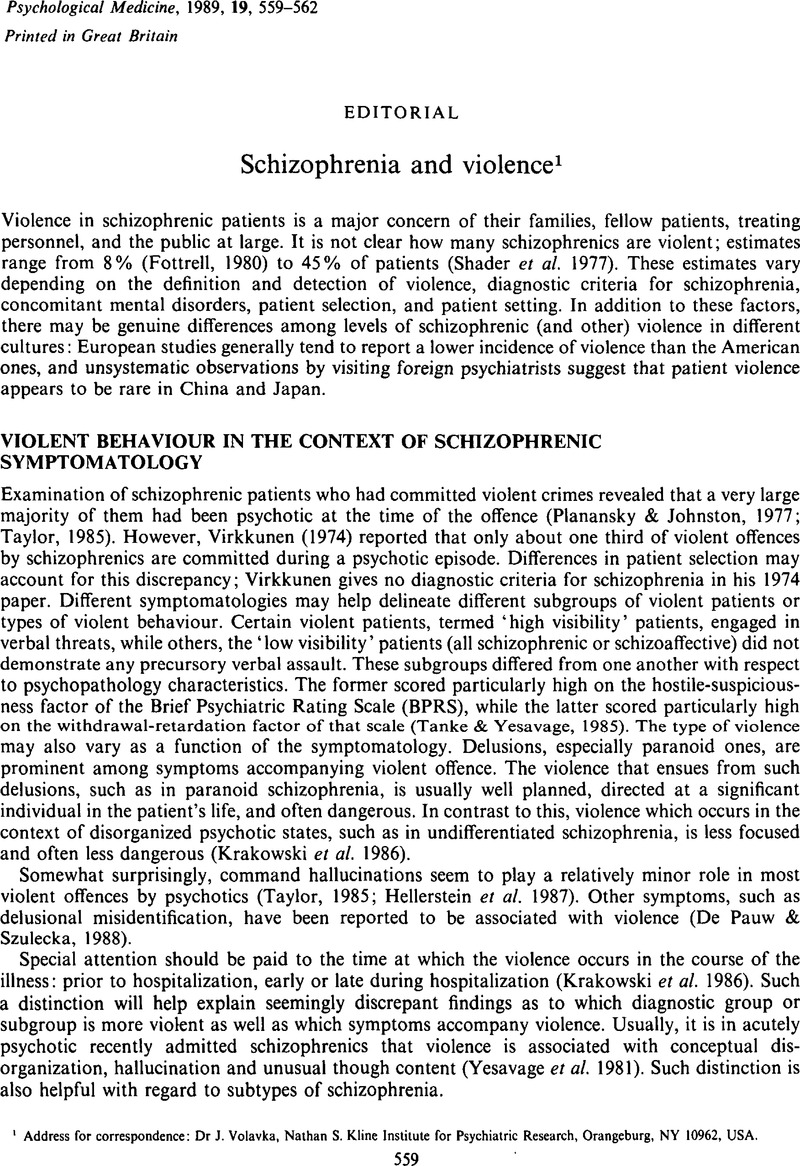Crossref Citations
This article has been cited by the following publications. This list is generated based on data provided by Crossref.
1990.
A Guide to the Literature on Aggressive Behavior.
Aggressive Behavior,
Vol. 16,
Issue. 1,
p.
63.
Buckley, Peter
Walshe, David
Colohan, Hubert A
O'Callaghan, Eadbhard
Mulvany, Fiona
Gibson, Tessa
Waddington, John L
and
Larkin, Conall
1990.
Violence and Schizophrenia — a study of the occurrence and clinical correlates of violence among schizophrenic patients.
Irish Journal of Psychological Medicine,
Vol. 7,
Issue. 2,
p.
102.
Aquilina, C
1991.
Violence by Psychiatric In-Patients.
Medicine, Science and the Law,
Vol. 31,
Issue. 4,
p.
306.
Wong, Michael
Lumsden, John
Fenton, George
and
Fenwick, Peter
1993.
Violence ratings of special hospital patients.
The Journal of Forensic Psychiatry,
Vol. 4,
Issue. 3,
p.
471.
Mueser, Kim T.
1993.
Handbook of Behavior Therapy in the Psychiatric Setting.
p.
269.
Smoyak, Shirley A.
and
Gorman, D. M.
1994.
Handbook of Aggressive and Destructive Behavior in Psychiatric Patients.
p.
33.
Linaker, Olav M.
1994.
Assaultiveness Among Institutionalised Adults with Mental Retardation.
British Journal of Psychiatry,
Vol. 164,
Issue. 1,
p.
62.
Wirshing, William C.
Ames, Donna
Marder, Stephen R.
and
Hicks-Gray, Tara
1994.
Handbook of Aggressive and Destructive Behavior in Psychiatric Patients.
p.
203.
VILLENEUVE, DAVID B.
and
QUINSEY, VERNON L.
1995.
Predictors of General and Violent Recidivism among Mentally Disordered Inmates.
Criminal Justice and Behavior,
Vol. 22,
Issue. 4,
p.
397.
Wong, Michael
Fenwick, Peter
Fenton, George
Lumsden, John
Maisey, Michael
and
Stevens, John
1997.
Repetitive and Non-Repetitive Violent Offending Behaviour in Male Patients in a Maximum Security Mental Hospital – Clinical and Neuroimaging Findings.
Medicine, Science and the Law,
Vol. 37,
Issue. 2,
p.
150.
Citrome, Leslie
and
Volavka, Jan
1997.
Psychopharmacology of Violence: Part I: Assessment and Acute Treatment.
Psychiatric Annals,
Vol. 27,
Issue. 10,
p.
691.
Cheung, Peter
Schweitzer, Isaac
Crowley, Kathleen
and
Tuckwell, Virginia
1997.
Aggressive Behaviour in Schizophrenia: The Role of Psychopathology.
Australian & New Zealand Journal of Psychiatry,
Vol. 31,
Issue. 1,
p.
62.
Barratt, Ernest S.
Stanford, Matthew S.
Felthous, Alan R.
and
Kent, Thomas A.
1997.
The Effects of Phenytoin on Impulsive and Premeditated Aggression.
Journal of Clinical Psychopharmacology,
Vol. 17,
Issue. 5,
p.
341.
Cheung, Peter
and
Schweitzer, Isaac
1998.
Correlates of Aggressive Behaviour in Schizophrenia: An Overview.
Australian & New Zealand Journal of Psychiatry,
Vol. 32,
Issue. 3,
p.
400.
Volavka, Jan
and
Citrome, Leslie
2000.
Violence among the Mentally III.
p.
193.
Citrome, Leslie
and
Volavka, Jan
2000.
Management of Violence in Schizophrenia.
Psychiatric Annals,
Vol. 30,
Issue. 1,
p.
41.
Joyal, C. C.
2005.
Schizophrénie et violence : mise à jour des connaissances et spécification des motifs et circonstances associés.
Psychiatrie et violence,
Vol. 5,
Issue. ,
Arango, C.
Bombín, I.
González-Salvador, T.
García-Cabeza, I.
and
Bobes, J.
2006.
Randomised clinical trial comparing oral versus depot formulations of zuclopenthixol in patients with schizophrenia and previous violence.
European Psychiatry,
Vol. 21,
Issue. 1,
p.
34.
Abushua'leh, Khalid
and
Abu-Akel, Ahmad
2006.
Association of psychopathic traits and symptomatology with violence in patients with schizophrenia.
Psychiatry Research,
Vol. 143,
Issue. 2-3,
p.
205.
Joyal, Christian C.
Côté, Gilles
Meloche, Julie
and
Hodgins, Sheilagh
2011.
Severe Mental Illness and Aggressive Behavior: On the Importance of Considering Subgroups.
International Journal of Forensic Mental Health,
Vol. 10,
Issue. 2,
p.
107.





